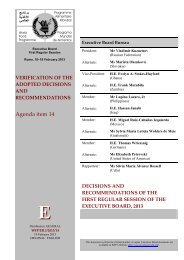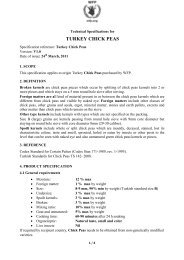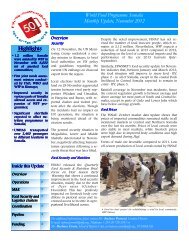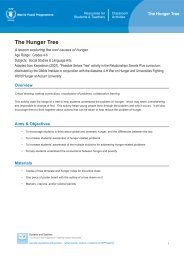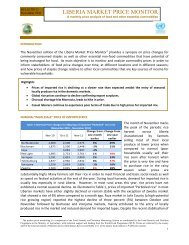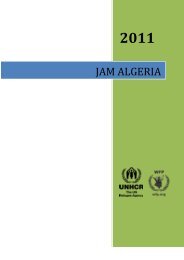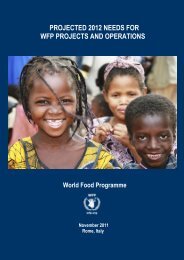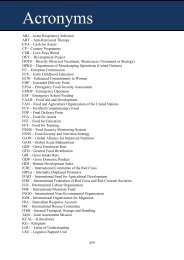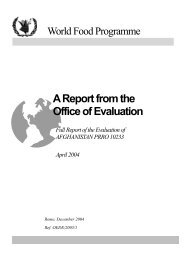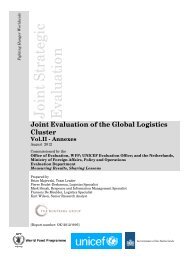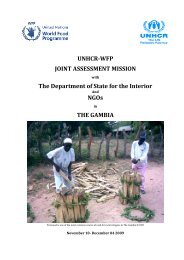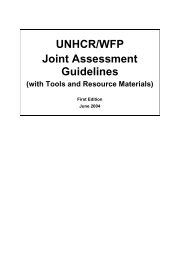Full Report - WFP Remote Access Secure Services
Full Report - WFP Remote Access Secure Services
Full Report - WFP Remote Access Secure Services
You also want an ePaper? Increase the reach of your titles
YUMPU automatically turns print PDFs into web optimized ePapers that Google loves.
<strong>Full</strong> <strong>Report</strong> of the Evaluation of the Kosovo EMOP 6040<br />
characterised by periodic outbreaks of violence which led to new displacement of the population.<br />
In February 1999, peace talks were held in Rambouillet, France, but ended inconclusively.<br />
During this period, the Serb authorities in Belgrade did not request food aid for Kosovo, but local<br />
authorities were partly co-operative in assisting <strong>WFP</strong>/UNHCR food convoys to reach areas<br />
previously inaccessible.<br />
An escalation of violence in Kosovo and large-scale expulsion and exodus of ethnic Albanian<br />
Kosovars followed this impasse. Many sought refuge in Albania, FYRoM, Montenegro and BiH.<br />
Some have received asylum in more distant countries under the Humanitarian Evacuee<br />
Programme. And many others were or are still internally displaced.<br />
A major offensive in late July forced up to 70,000 people to flee to the mountains in Kosovo. More<br />
people were displaced in mid-August. The local NGO, Mother Theresa Society (MTS) reported<br />
more than 300,000 IDPs scattered throughout the country. UNHCR and <strong>WFP</strong> accepted the figure<br />
as a planning figure. The international NGO Mercy Corps International (MCI), CRS and the MTS<br />
were considered viable implementing partners for the food distribution.<br />
The MTS has branches throughout the Kosovo. The organisation was and still is the most<br />
important NGO for the distribution of food and other items and services in Kosovo. It continued<br />
operating before, during and after the bombing. While <strong>WFP</strong> and the larger international NGOs<br />
brought in the food, MTS was responsible for distribution to the beneficiaries.<br />
Distributions were to be on short cycles to allow adjustments to the constantly changing situation<br />
and the movements of the target groups. Whilst the conflict continued, ad hoc convoys would<br />
make immediate deliveries of food to areas in acute need.<br />
3.2.3 Albania<br />
In Albania, the government food stocks were still limited after the internal crisis of 1997,<br />
precipitated by the collapse of the so-called pyramid schemes. The government was very cooperative<br />
but wanted to relocate the refugees as soon as possible away from the northern border.<br />
In May 1998, food was delivered to Albania from <strong>WFP</strong> stocks in Bosnia-Herzegovina and Ploce<br />
port (Croatia). A joint <strong>WFP</strong>/UNHCR assessment mission to northern Albania in early June 1998<br />
defined basic and supplementary food needs of the refugees arriving in the area. While refugees’<br />
immediate needs were met by other humanitarian organisations, their stocks were rapidly<br />
depleted, and <strong>WFP</strong> took on the main responsibility for providing food aid.<br />
In Albania, it was estimated that about 20,000 Kosovars had crossed the border into Albania<br />
since May 1998. The influx slowed down significantly when the border was closed on the Kosovo<br />
side. Border crossings picked up again in mid-August. In view of the potential for further influxes,<br />
UNHCR and <strong>WFP</strong> agreed on a planning figure of 50,000 refugees. <strong>WFP</strong> assistance was for<br />
30,000 refugees only, with 20,000 taken care of by other agencies.<br />
<strong>WFP</strong> had an office in Tirana and established a satellite office in northern Albania, where the<br />
refugees were concentrated. The offices were equipped with radios, some vehicles and office<br />
equipment, re-deployed from ongoing and previous operations in the region.<br />
<strong>WFP</strong> divided the beneficiary population with the IFRC, to ensure proper distribution of food and to<br />
avoid duplication. Further implementing arrangements with NGOs were worked out together with<br />
UNHCR. <strong>WFP</strong> managed and monitored the food aid in co-operation with the implementing<br />
partners.<br />
11



